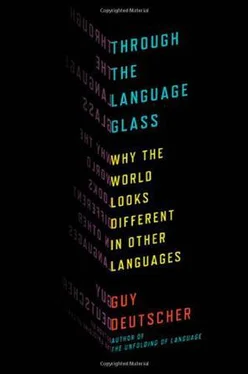In the 1960s, the linguist Susan Ervin tried to downplay the element of creativity with an experiment that involved Italian speakers. She relied on the fact that Italian has very diffuse dialects, so even a native speaker would not be at all surprised to encounter entirely unfamiliar words in an unfamiliar dialect. Ervin invented a list of nonsense words that sounded as if they could be the dialectal terms for various objects. Some of these ended in - o (masculine) and the others in - a (feminine). She wanted to check what associations these words would evoke in Italian speakers but did not want the participants to realize that they were indulging in creative imagination. So she told them they were going to see a list of words from an Italian dialect that they didn’t know, and she pretended that the aim of the experiment was to check whether people could guess correctly the properties of words merely by the way they sound. The participants tended to attribute to the - o words similar properties to those they attributed to men (strong, big, ugly), whereas the - a words tended to be described with properties that were also used for women (weak, little, pretty). Ervin’s experiment showed that associations were affected by the grammatical gender even when the participants did not realize they were indulging in creative imagination and assumed that the question before them had a correct solution. But while this experiment went some way toward overcoming the problem of subjective judgments, it still did not solve the problem completely, since even if the participants were not aware of being coerced to produce associations on demand, in practice this is exactly what they were required to do.
In fact, it is difficult to imagine how one could design any experiment that would completely bypass the influence of subjective judgments. For the task requires nothing less than having one’s cake and eating it too: how can any experiment measure whether grammatical genders exert an influence on speakers’ associations, without soliciting these speakers for their associations? A few years ago, Lera Boroditsky and Lauren Schmidt found a way to do exactly that. They asked a group of Spanish speakers and a group of German speakers to participate in a memory game (which was conducted wholly in English, in order to avoid any explicit mention of the genders). The participants were given a list of two dozen inanimate objects, and for each of these objects, they had to memorize a person’s name. For example, “apple” had the name Patrick associated with it, and “bridge” had the name Claudia. The participants were given a fixed period of time to memorize the names associated with the objects, then tested on how well they had managed. A statistical analysis of the results showed that they were better at remembering the assigned names when the gender of the object matched the sex of the person, and that they found it more difficult to remember the names when the gender of the object clashed with the sex of the person. For example, Spanish speakers found it easier to remember the name associated with “apple” ( la manzana ) if it was Patricia rather than Patrick, and they found it easier to remember the name for a bridge ( el puento ) if it was Claudio rather than Claudia.
Since Spanish speakers found it objectively more difficult to match a bridge with a woman than with a man, we can conclude that when inanimate objects have a masculine or feminine gender, the associations of manhood or womanhood for these objects are present in Spanish speakers’ minds even when they are not actively solicited, even when the participants are not invited to opine on such questions as whether bridges are strong rather than slender, and even when they speak English.
Of course, one could still object that the memory task in question was fairly artificial and at some remove from the concerns of everyday life, where one is not often called upon to memorize whether apples or bridges are called Patrick or Claudia. But psychological experiments often have to rely on such narrowly circumscribed tasks in order to tease out statistically significant differences. The importance of the results is not in what they say about the particular task itself but in what they reveal about the effect of gender more generally, namely that manly or womanly associations of inanimate objects are strong enough in the minds of Spanish and German speakers to affect their ability to commit information to memory.

There is always room for refinement and improvement in psychological experiments, of course, and those reported above are no exception. But the evidence that has emerged so far leaves little doubt that the idiosyncrasies of a gender system exert a significant influence on speakers’ thoughts. When a language treats inanimate objects in the same way as it treats women and men, with the same grammatical forms or with the same “he” and “she” pronouns, the habits of grammar can spill over to habits of mind beyond grammar. The grammatical nexus between object and gender is imposed on children from the earliest age and reinforced many thousands of times throughout their lives. This constant drilling affects the associations that speakers develop about inanimate objects and can clothe their notions of such objects in womanly or manly traits. The evidence suggests that sex-related associations are not only fabricated on demand but present even when they are not actively solicited.
Gender thus provides our second example of how the mother tongue influences thought. As before, the relevant difference between languages with and without a gender system is not in what they allow their speakers to convey but in what they habitually force their speakers to say. There is no evidence to suggest that grammatical gender affects anyone’s ability to reason logically. Speakers of gendered languages are perfectly able to understand the difference between sex and syntax, and are not under the illusion that inanimate objects have biological sex. German women rarely mistake their husbands for a hat (even though hats are masculine), Spanish men are not known to confuse a bed with what might be lying in it, and animism does not seem to be more widespread in Italy or Russia than in Anglo-Saxonia. Conversely, there is no reason to suspect that speakers of Hungarian or Turkish or Indonesian, which do not make gender distinctions even on pronouns, are in any way constrained from understanding the finer points about the birds and the bees.
Nevertheless, even if grammatical gender does not restrict anyone’s capacity for reasoning, that does not make its consequence any less severe for those immured in a gendered mother tongue. For a gender system may come close to being a prison-house nevertheless-a prison-house of associations. The chains of associations imposed by the genders of one’s language are all but impossible to cast off.
But if you native speakers of English are tempted to feel sorry for those of us who are shackled by the heavy load of an irrational gender system, then think again. I would never want to change places with you. My mind may be weighed down by an arbitrary and illogical set of associations, but my world has so much to it that you entirely miss out on, because the landscape of my language is so much more fertile than your arid desert of “it’s.”
It goes without saying that genders are language’s gift to poets. Heine’s masculine pine tree longs for the feminine palm; Boris Pasternak’s My Sister Life can work only because “life” is feminine in Russian; English translations of Charles Baudelaire’s “L’homme et la mer,” however inspired, can never hope to capture the tempestuous relationship of attraction and antagonism that he evokes between “him” (the man) and “her” (the sea); nor can English do justice to Pablo Neruda’s “Ode to the Sea,” in which the (masculine) el mar strikes a stone ( una piedra ) and then “he caresses her, kisses her, drenches her, pounds his chest, repeating his own name”-the English “it caresses it, kisses it, drenches it, pounds its chest” is not quite the same.
Читать дальше












